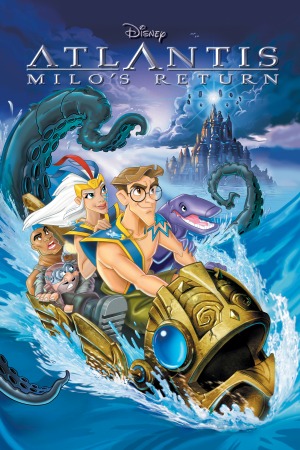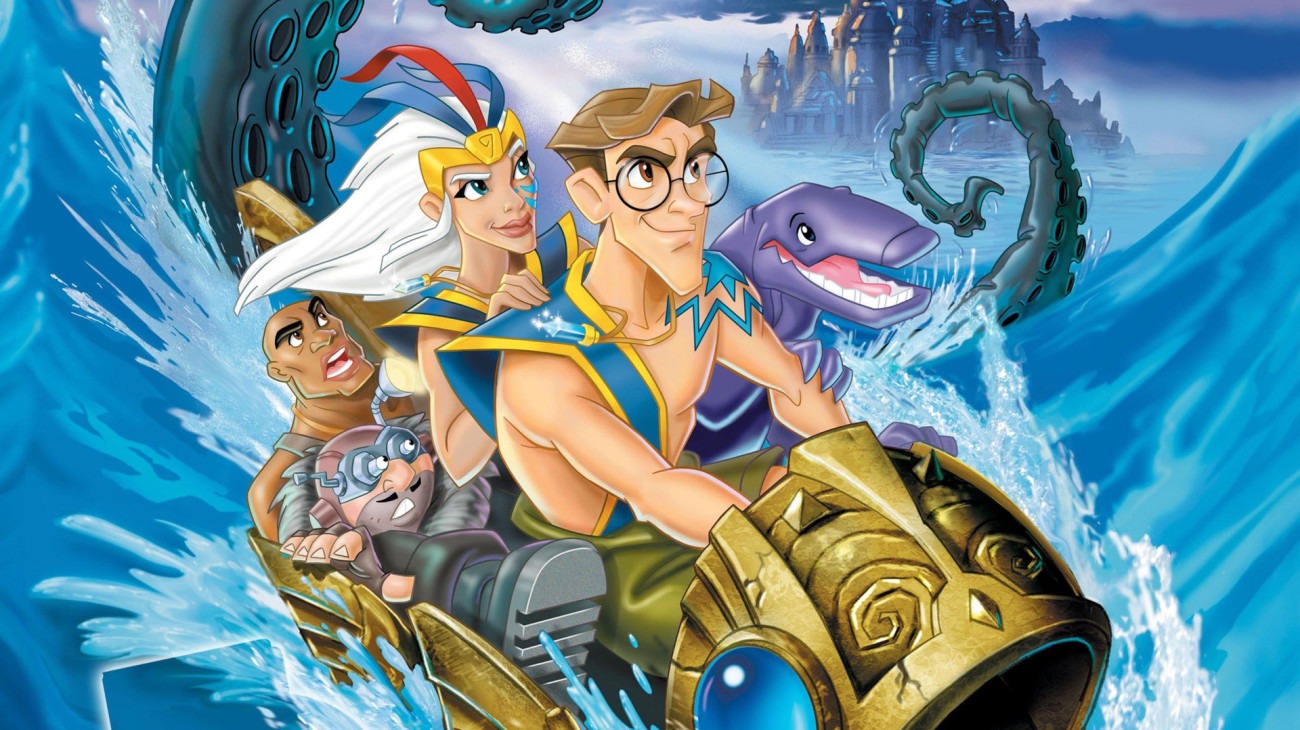
Disney Sequels: Hearts In Atlantis
Atlantis: The Lost Empire was the first of two overt attempts in the early '00s by the Walt Disney Company to court an adolescent male audience with its animated feature films, a quest that even a decade and change later still seems unreasonably dumb to me. Adolescent males are and were the one market segment practically guaranteed to have no interest in theatrical animation, no matter how much anime you rip-off and how much Mike Mignola does the character designs. But Disney - that is, CEO Michael Eisner, who had by this point entered the "Norma Desmond" stage of being detached from the world around him - was dogged. So enthusiastic was the corporation about how Atlantis was going to sweep in a huge new audience of boys who'd just been sitting on pins and needles waiting for a male protagonist and a complete dearth of musical numbers, they began plans for a television series, Team Atlantis, to continue the adventures as the character investigated different legends and paranormal phenomena around the globe. You know, in case it wasn't already sufficiently obvious that this was a shameless copy of Stargate.
Sadly, Disney's enthusiasm was monumentally misplaced, and Atlantis went on to be a flop: not as massive a flop as the second and last of Disney's overt attempts to seduce teenage males, Treasure Planet, but more than enough to make the idea of a TV spin-off seem laughably hubristic. That being said, enough time had been sunk into Team Atlantis to squeeze out three episodes, and like Belle's Magical World a half-decade earlier, the executives figured that at least some damage control could be done: the three episodes were stretched out by a few extra minutes of animation linking them together and adding a framework narrative, and a wholly perfunctory wrap-up taken from the also-cancelled Atlantis 2: Shards of Chaos. The resulting feature-lengthy hybrid was released to video just shy of two years after Atlantis sank without a trace, under the title Atlantis: Milo's Return, which no more accurately describes its content than a lot of other possibilities, but it's not like anybody cared nearly enough to put more than a lunch meeting's worth of thought into it (I don't honestly see why Team Atlantis wasn't a better choice, but maybe it was just a desire to bury all the memory of that project).
It's hardly right to suggest that what emerges from this has a "plot", though by God they try to pretend it does. After a subtitled prologue in Norwegian establishes the time (right after World War I) and the threat (something gigantic with tentacles), we arrive in the undersea kingdom of Atlantis, where Queen Kida (Cree Summer) and her new consort, linguistic expert Milo Thatch (James Arnold Taylor, the only major part that was re-cast) are using the magic of Atlantis's energy crystals to patch up the centuries-decayed city. Just as they're putting the final touches on a restored and revitalised empire of wonders, Milo's old adventure buddies, Audrey the mechanic (Jacqueline Obradors), Vinny the demolitions expert (Don Novello), Dr. Sweet (Phil Morris), and the unnecessarily creepy French digging expert and soil-eater Mole (Corey Burton), come back to Atlantis, taking not nearly as much effort to do so as I feel like the end of the feature implied that it should. They've come with eccentric rich person Preston Whitmore (John Mahoney), who wants to recruit Milo's help to fight a new threat: the old Norse legend of the Kraken has come back into fashion, after several ships have gone missing in the north Atlantic. Milo and Kida eagerly hop up to the surface, and the whole lot of them get to investigating, finding out that the Kraken is taking down ships, but apparently it's a ghost or something.
Having dealt with this threat, Milo and Kida are ready to return to Atlantis, but they are unexpectedly called to Arizona, where reports of spectral coyotes made of wind and sand have surfaced, and apparently it matters that these people specifically go and investigate. I mean, it does matter, because there turns out to be an ancient city proving that the Atlanteans had a foothold in the Americas, but there's absolutely no reason for anybody to suspect that at the story's start.
Milo and Kida are ready to return to Atlantis again, but an old colleague of Whitmore's, Erik Hellstrom (W. Morgan Sheppard), has stolen an ancient spear of Atlantean extraction from Whitmore's collection, and is now crazy and thinks he's Odin. Off they all go to Iceland, to deal with that problem, and finally Milo and Kida can get the hell back home.
I will first point out that Team Atlantis, allegedly, wasn't going to be so damn arbitrary: my understanding is that the route back to Atlantis is closed somehow, so instead of Milo and Kida being pestered with problems that really don't require their attention, like houseguests who are being detained by a chatty host, part of the series was indeed going to concern their attempts to find ways to make it back, using all the Atlantean technology they were hunting down. But that's a cold comfort in watching Milo's Return, where the Arizona episode in particular feels like a profoundly forced attempt to cram the protagonists where they don't belong, in some kind of half-assed ad-hoc '20s version of The X-Files.
Purely on the level of being a sequel, it's also a bit dismaying that all three of the episodes rely more or less on magic (the first two explicitly, the third rather less so, though Fake-Odin still has magical ravens that the script tends to forget about), for where Atlantis certainly got bogged down in mysticism and "it works because we say it works" technobabble, it at least claimed that everything we saw was scientific in a sufficiently removed, Clarke's Law sort of way. Jumping into full-on paranormal monster stories - and the Kraken episode in particular cannot possibly be resolved in any other way than be resorting to "ooh, spooky magic!"; it is generally speaking the worst of the three individual stories, resolving not because anything is explained in a way that makes sense, but simply because everything that needed to be dead is dead, and there's no point in hanging around asking why - is a violation of that sensibility.
Anyway, the whole damn thing is pretty dreadfully boring, and I cannot imagine how this could have remained terribly novel or bearable for the entirety of the proposed 39-episode run. Who knows if it's all the fault of the Milo's Adventure retrofitting that sucked all of the stakes out of the narratives, but in the form they currently hold, everything is trivial and does not build up remotely the mythology that the concluding scenes appear to believe has been done.
Visually, it's not a complete washout. The heavily anime-inflected style of the original movie, which I've always felt was a fairly disastrous fit for Disney's animation studio, at least has the benefit of being easily transferrable, and while Milo's Return is clearly cheaper than Atlantis - it has a lower frame-rate and a considerably narrow range of available colors - it's not as horrifying as some of the DTV sequels, wherein the traditional Disney character designs prove too much for the various satellite studios to handle (the satellite being, in this case, Toon City out of the Philippines). The angular, graphic style is already what cheapened animation looks like, which makes it easier to replicate the quality of the original, in an exceedingly general sense. It's still not flawless; we're still expected to believe that this shot of Milo staring behind Kida's head is an image of two people in love nuzzling:
But for the most part, the thing looks tolerable. Better than tolerable, even, in some cases; the sand wolves in Arizona are genuinely effective bit of design and animation, vague enough to be creepy and specific enough to land as a genuine, credible threat.
Sometimes, of course (this being a cheap-ass Disney television project turned DTV castoff), it's less than tolerable: this woman, for example, is not a flesh-eating zombie. In fact, she's meant to be sympathetic. Though how in the hell we're meant to sympathise with anything in this shot is a mystery to me.
Things like that are more of an exception than the norm, though, and on the scale of Disney's sequels promoted up out of TV episodes, Milo's Return is at least as good as The Return of Jafar, certainly better than Tarzan & Jane, and so much better than Belle's Magical World that it basically doesn't even make sense to use comparatives that point.
No, the great heaving monstrous issues with Milo's Return are mostly limited to its absolute failure on any kind of storytelling level. I am by no means a fan of Atlantis, either on the level of animation or narrative; but it's at least functional. That's something I refuse to say about Milo's Return: it refuses to explain what's going on or why we care or how it all ties together, and knowing that this is a result of its broken production history does not remotely absolve it; because we got it in this form, and in this form it's just a sputtering series of half-baked plot threads that shrivel up and die. Even if its marginally more attractive junk than some of its most obvious comparisons, it's still junk, giving us no reason, however remote, to care one iota about the things happening onscreen or to wonder in amazement at the world being assembled. Or not assembled, as is actually the case.
Categories: adventure, animation, disney, fantasy, needless sequels











